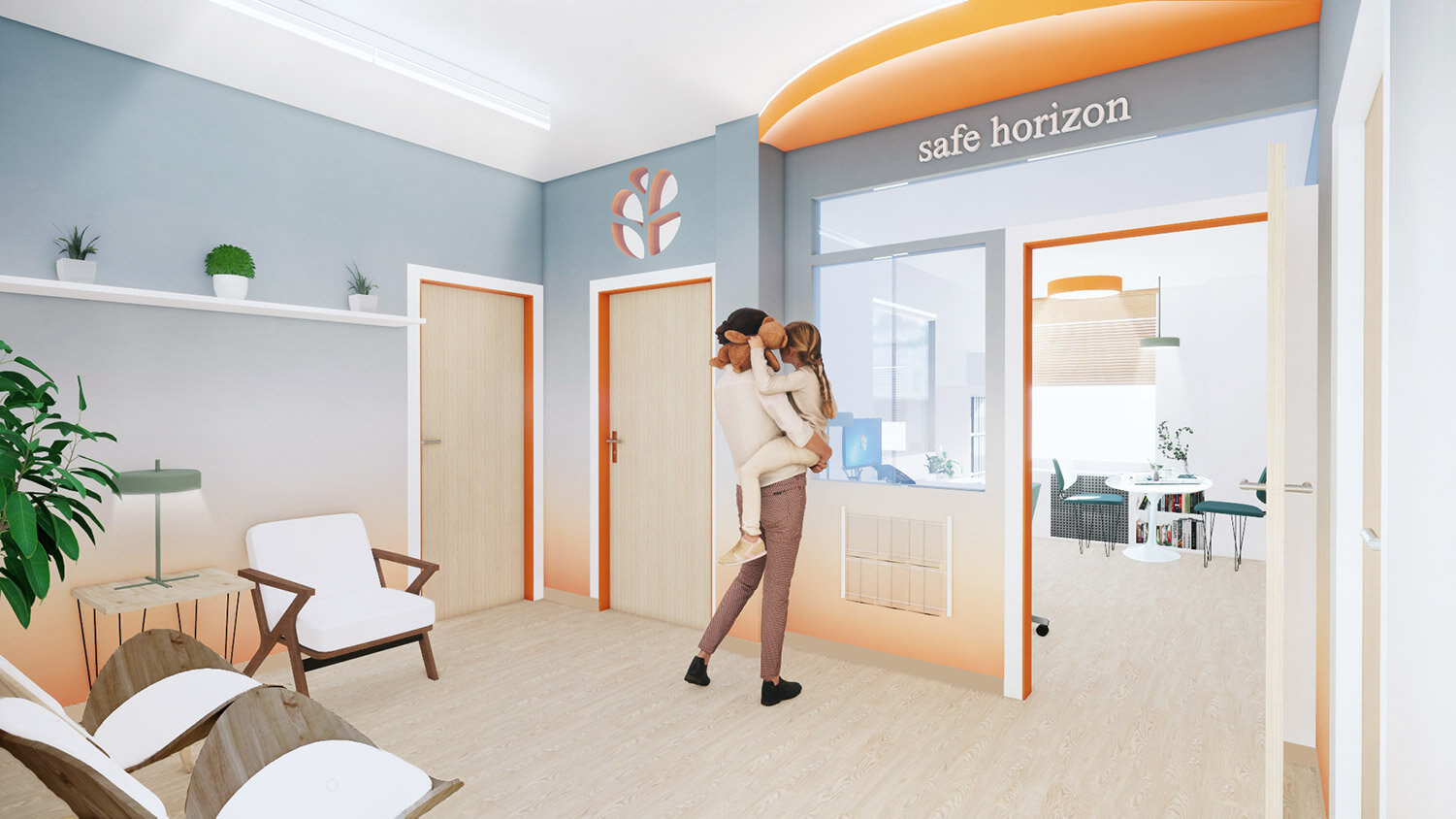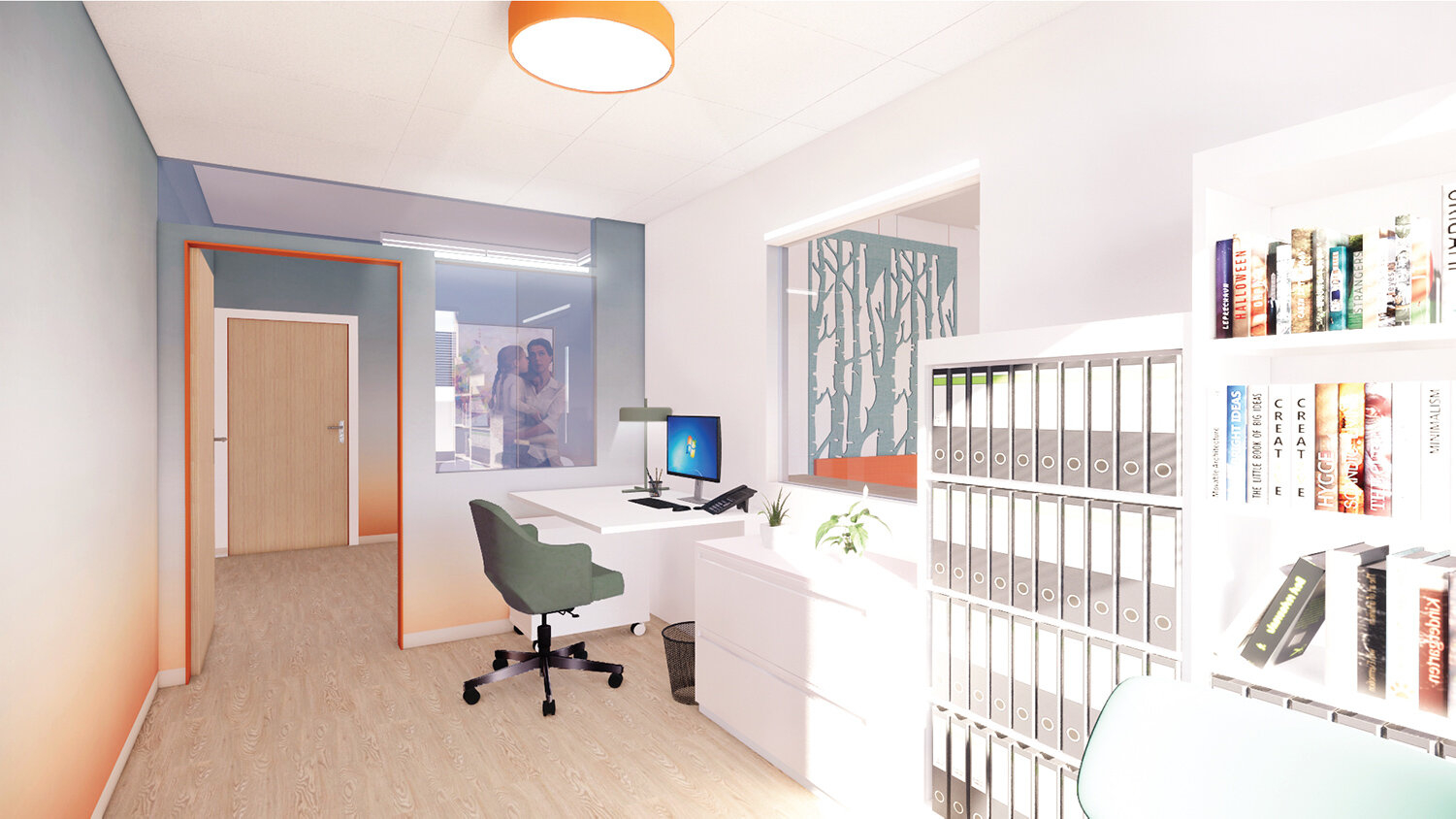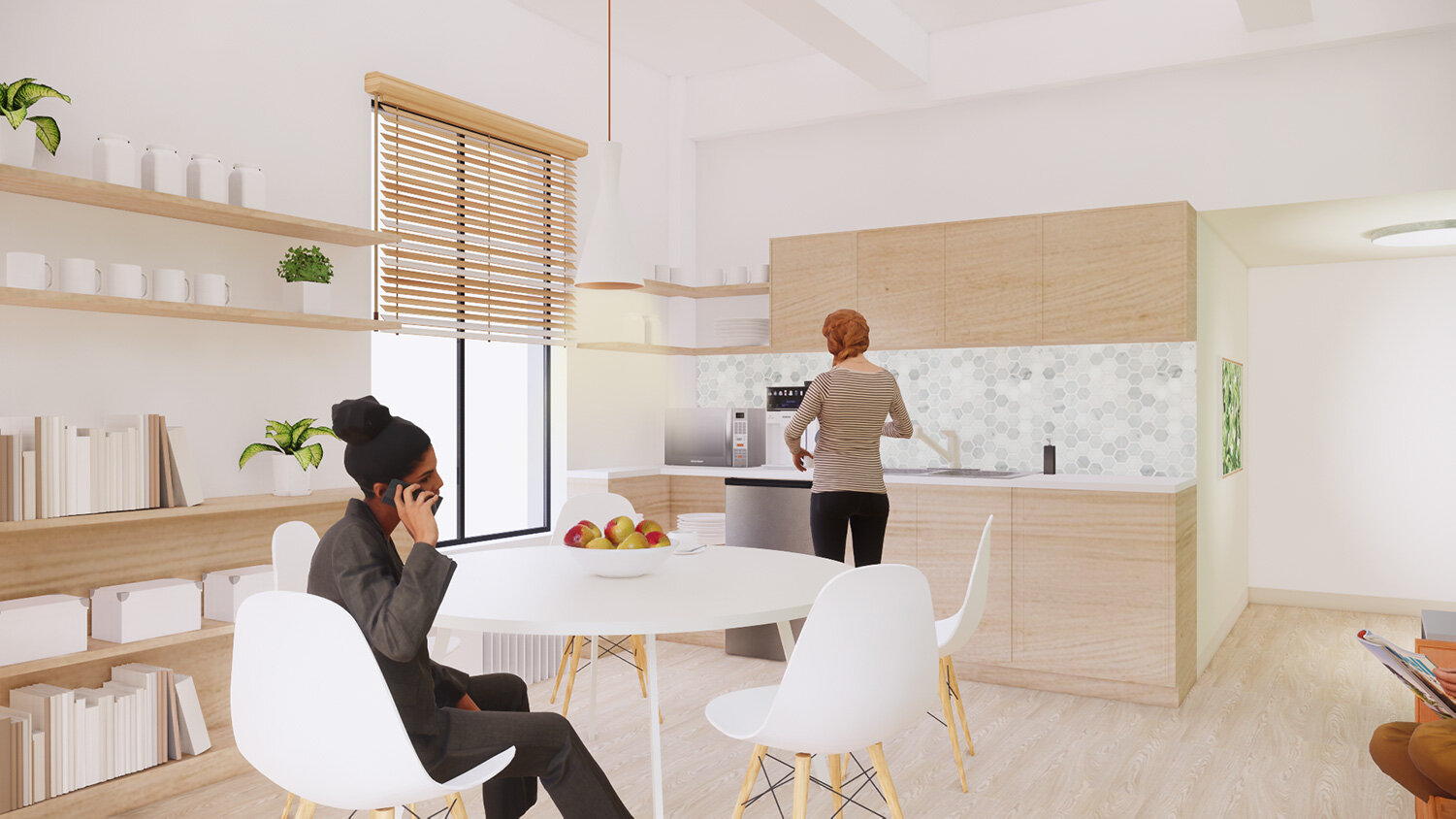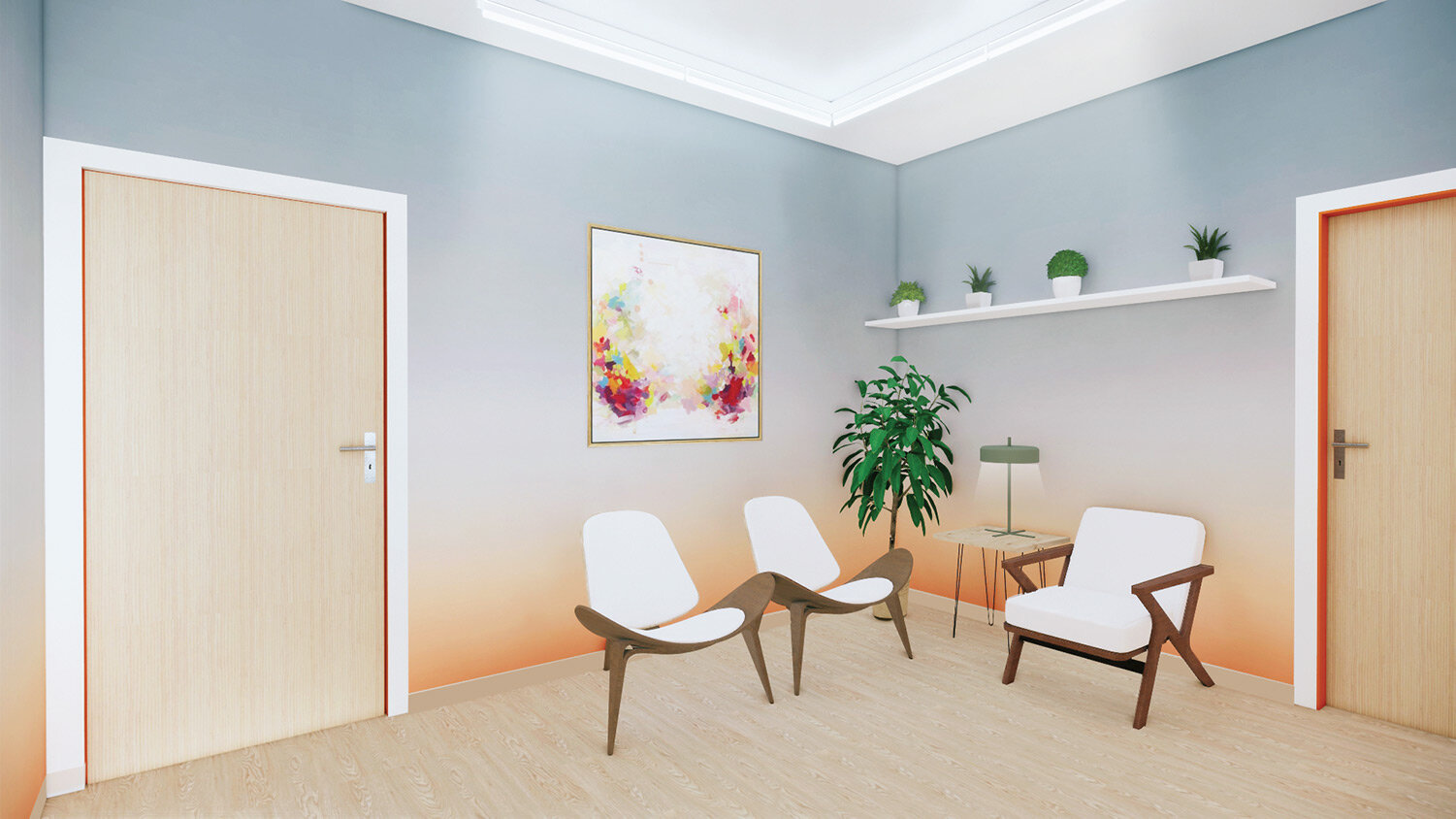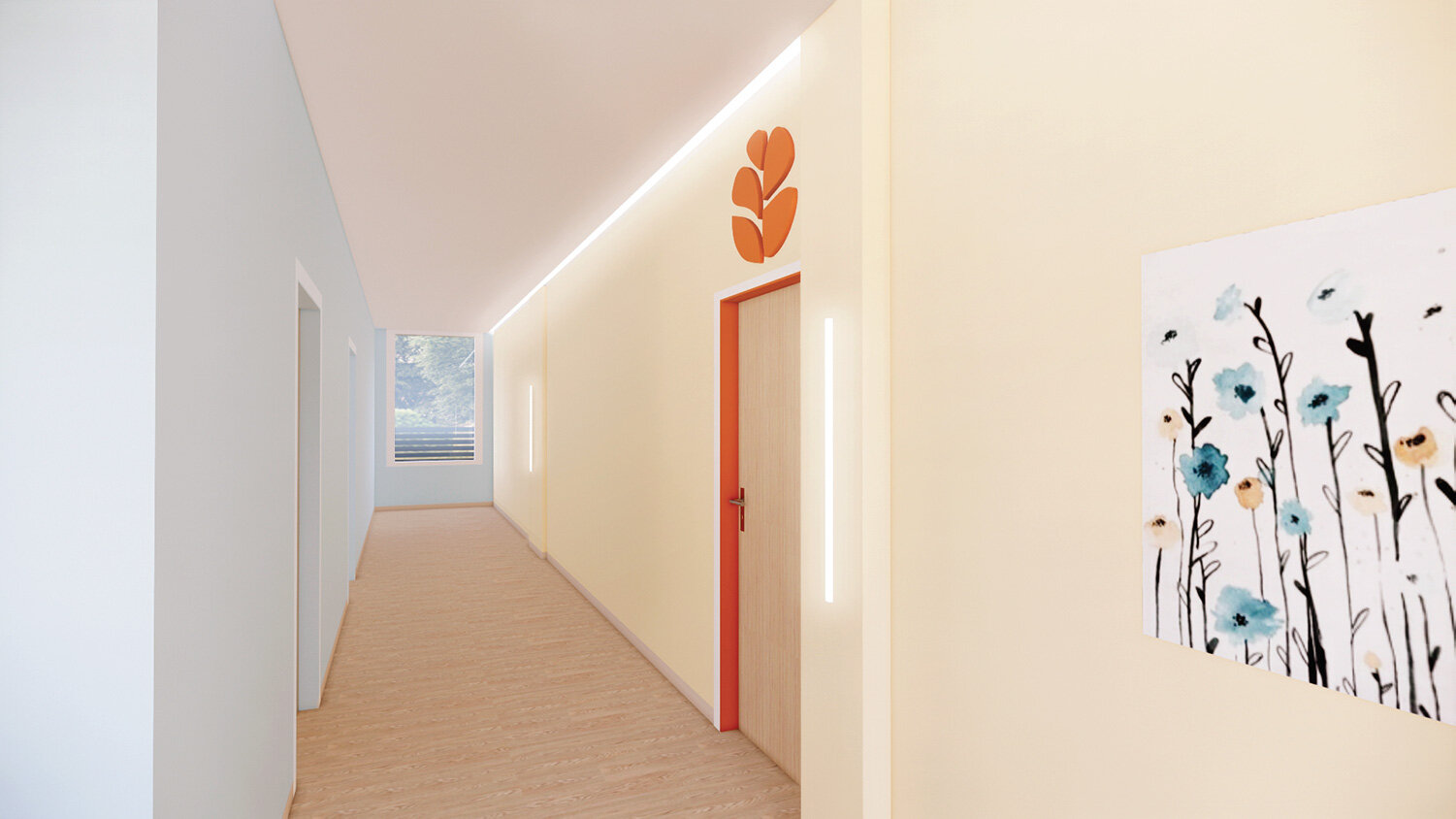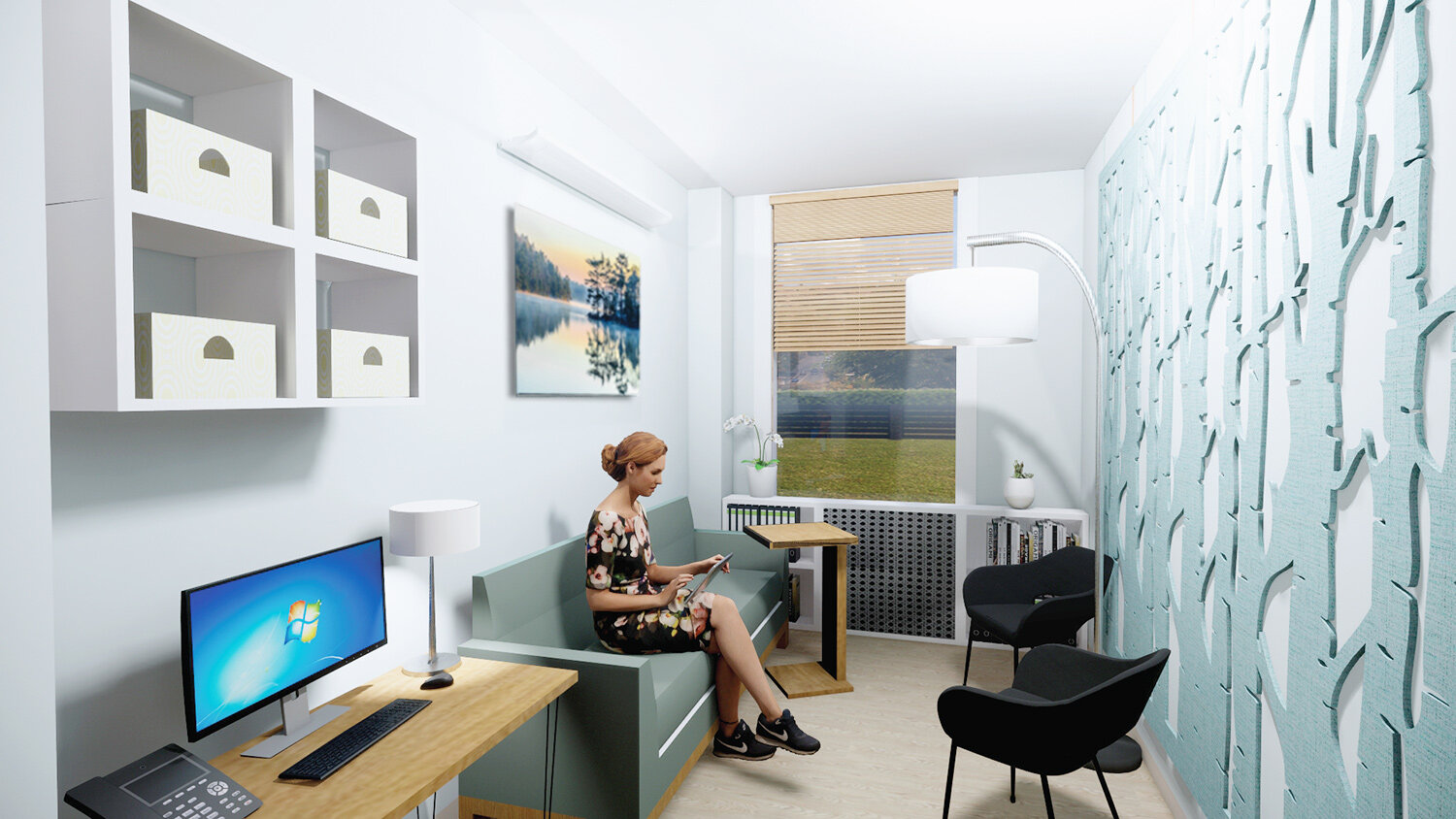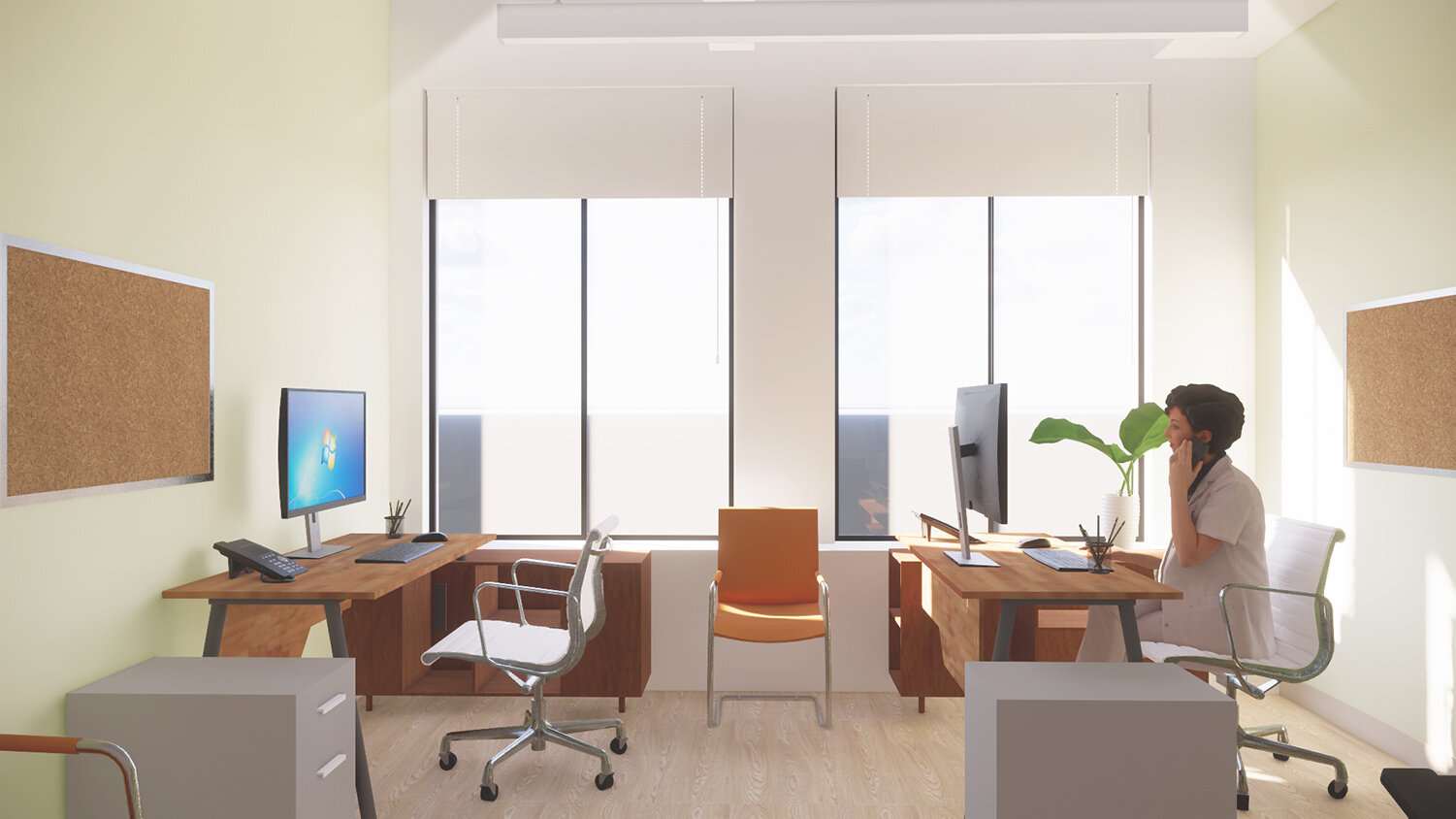Cause Design Can Change You
There Has Never Been a Better Time to Give Back
MFA-1 students Mika Jiaravanont ’20 and Joanne Park ’20 spent the past two summers participating in community service projects for Safe Horizon, an organization that provides shelter, counseling, and other services to victims of violence. Here’s a deep dive into their experiences and an overview of the two sections being conducted remotely this summer.
Rendered section perspective of the staff area in Safe Horizon’s Staten Island community program office.
Problem Solving for Real Clients
Joanne Park felt challenged by the task at hand as she and her team left a client meeting at their new project site last summer. Perhaps victims of violence, and the social workers who take care of them, need the calming and organizing power of design more than anyone because they deal with so much daily stress and sadness. However, the Safe Horizon community program office that the NYSID team was charged with redesigning—like so many of the spaces where social justice happens—was dark, disorganized, overstuffed, and run down. Nobody had thought out how the space could help people live and work better until the service learning studio team entered the picture.
The students from NYSID—Yangfangfei Gao, Mallie Gusset, Karina Infante, Mika Jiaravanont, Nico Liu, and Joanne Park—were responsible for redesigning a space that was both a workplace for social workers and staff and a counseling center for adult and child survivors of violence and their families. Park’s team, one half of the group, worked on the plan for the counseling rooms, the adult and child waiting rooms/reception areas, and a conference room for staff, while the other team, which included Jiaravanont, worked on staff offices and the break room.
The building faced the ocean, and the NYSID group knew it would be best to move the counseling rooms to give Safe Horizon clients a view of the sea because research shows that natural beauty and light help people with trauma feel more at ease. Safe Horizon had several end-user requirements. Parents needed to have a view of their children in the kids’ waiting room from every counseling room, the children’s and adults’ waiting areas had to be distinct from one another, and the staff conference room needed to convert into a counseling room for a large family in a pinch. Also, the waiting areas had to be welcoming with an effective wayfinding system, so that clients would feel agency rather than insecurity when they arrived. There was more to this project than picking furniture and finishes—it required demolition and a total rethink of the space’s circulation.
At first, the NYSID team was stumped by so many use-parameters from Safe Horizon and the tight budget. The students brainstormed, and every member of the team contributed ideas, but it was challenging to bring them all together. “We could not move forward until we came up with a floor plan and solved the circulation issues,” remembers Park. “I was sitting at the Staten Island Ferry Station with Terry [Kleinberg], and then I began to scribble. With hundreds of people around us, on a public seat, waiting for a boat, Terry and I pulled all of the team’s ideas and client’s feedback together to solve the circulation problem. We put the conference room in the center of the building.” This bolt of inspiration completely changed Park’s confidence as a designer.
The 2019 NYSID Service Learning Team (L to R): Karina Infante, Mika Jiaravanont, Terry Kleinberg, Nico Liu, Mallie Gusset, Joanne Park, and Yangfangfei Gao.
A Service Learning Overview
NYSID requires all MFA-1 students to participate in summer experiential learning. The options include the service learning studio, an internship with an accompanying online course, a graphics course, independent study, or study travel. This year the College expanded the service learning offerings to fill the gap created by a lack of travel and internship possibilities in the wake of COVID-19. But, service learning has always been a great option, especially for students between their first and second years.
“The service learning studio empowers students by allowing them to interact with end-users,” says architect Terry Kleinberg, the principal of her eponymous firm and NYSID’s service learning studio instructor. “Our students are not working on an isolated part of the process assigned to them by a superior; they are running the whole design process. They have to get into the minutia of how people use spaces and engage in real problem solving, which is difficult and meaningful work.” The first week of this eight-week course is focused entirely on research. NYSID librarians give a presentation on research methods, and at the end of the week, each student presents the results of their work. Topics may include trauma-informed design, stress management for staff, and statistical research on the population they are serving. The following week, the whole NYSID group goes to the site and visits the clients. At Safe Horizon, for example, they observed how victims of violence and staff members behave in the space, and interviewed all of the stakeholders, from administrators to social workers to maintenance workers. They could not interview victims of violence because of Safe Horizon’s privacy protocols.
In the following weeks, the teams alternate in-class pin-ups of their design work with presentations to the client, so there are several opportunities to go back to the studio and incorporate client feedback. Every year, NYSID faculty member Eric Cohen, senior associate principal at Ethelind Coblin Architect, serves as a mentor by attending the in-class pin-ups and providing critiques. The students work with real budgetary constraints and a list of approved vendors. In week eight, there’s a final presentation at which the NYSID team hands over a complete and usable set of drawings, renderings, and specifications of all materials and products. “They work very hard and rise to the occasion. The clients are always bowled over,” says Kleinberg.
The service learning program began in 2015, and during its first two years, students designed renovations for New York City police stations. For the past three years, NYSID students have donated their considerable talents to Safe Horizon: In 2017, they designed a child advocacy center in Queens; the following summer, a domestic violence shelter in Harlem; and this past summer, the non-profit’s office and counseling center on Staten Island. Kleinberg notes, “At the Queens Child Advocacy Center, a donor saw the plans and renderings our students created and wrote a check for $20,000 on the spot so that the counseling rooms could be built.”
The Power of Collaboration and Self-Direction
Park remembers choosing between an internship and service learning at the end of her first year in the MFA-1 program. She says, “As a first-year student, I felt like I didn’t have enough experience under my belt or the technical skills to fly solo in a job.” When she entered the service learning program, she found it radically different from her schoolwork. She says, “In school, we work individually most of the time, but real design work is collaborative. It was fun and challenging to work as a team. We had to divide up the work, and assign ourselves deadlines, make use of each other’s strengths. This was a huge growth experience for me.”
Jiaravanont agrees that collaboration was one of the best aspects of the service learning experience, and she especially values that Shaun Fillion, the director of NYSID’s Masters of Professional Studies in Lighting Design (MPS-L), arranged for MPS-L students to consult on the projects both summers. “Being able to work with the lighting students was very helpful,” Jiaravanont says. “One thing the Safe Horizon staff expressed is that their spaces were dark, that they needed light, both artificial and natural, to get them through taxing days. Lighting is important for people dealing with trauma. Both summers, I learned about lighting with warmer temperatures, using indirect lighting to cast a more ambient glow, using direct lighting only on art pieces and work stations, and applying lighting as a strategy for wayfinding.” The team is grateful to the 2019 summer volunteers from the MPS-L program, Brigid Hardiman and Jessica Doyle.
Park and Jiaravanont planned to do only one summer of service learning, but they both chose to do another because they didn’t want to miss a second opportunity to work with Terry. “I wanted to work with Terry again.” Jiaravanont explains, “She has such deep knowledge and passion for this work.” Park adds, “She’s the perfect instructor for this course. She guides you with questions, and lets you find your own solutions.”
Park juggled an internship at Morris Adjmi Architects with the service learning studio during the second summer of the MFA-1 program, and though she admits the experience was tough, she’s glad she did it. She says, “The second year of the service learning studio, I was in a mentorship role. I didn’t think I had that in me, but I do, and I’m grateful to have discovered it. I had to multitask and time manage, so I found myself messaging my classmates every day, assigning them tasks and deadlines. My ability to do this was a revelation. I thought: Maybe I can become a project manager one day.” Park stresses that though their status as the second-year veterans put both her and Jiaravanont in the position of mentoring peers last summer, every student in the service learning program was an equal member of the team. “Everyone brings a different talent, and the thinking comes from all of us,” says Park.
The autonomy built into service learning gives the students a chance to apply the technical skills they have learned in their academic work. The 2019 group wanted their client to get a sense of how users would move through the space, so they used Enscape, a program Park and Jiaravanont learned in their second year, to create a virtual walkthrough of their design plans. Like all other aspects of the final presentation, this initiative came from the students, and it thrilled the clients. “It was very satisfying, in the end, to know I was helping better the lives of people who really needed my help,” says Park. Adds Jiaravanont, “I hope to take what I’ve learned about how to serve people and the community into any design job that I have in the future.”
Service Learning Project, Summer 2019: The Safe Horizon Staten Island Community Program Office
Summer 2020
With many internship programs canceled or on hold because of the pandemic, NYSID added a second section of the service learning studio so that more students would get a chance to do real world design. One team is designing a domestic violence shelter for Safe Horizons, a task that will bring new challenges as the need to create social distance for the residents of shelters grows. The other is working with the SUNY College of Optometry and redesigning a 15,000 SF floor of their University Eye Center in Manhattan—a facility where they treat people with vision impairments and traumatic brain injuries. One challenge is re-envisioning a waiting area shared by noisy children and people with traumatic brain injuries, who cannot tolerate noise or bright light. The doctors, administration, and staff are excited to share research on the needs of the vision impaired with students. Designing a hospital environment is particularly relevant now, in the era of COVID-19. Both sections of the course are being conducted at a distance, using tools such as Zoom for client meetings. Safe Horizons and the SUNY College of Optometry provided students with virtual tours of the spaces, as well as floor plans. For as long as necessary, students will design from a distance, just like established designers are doing during the lockdown period.
Trauma-Informed Design
For people who have experienced trauma, overstimulating environments can trigger confusion, fear, traumatic memories, and the impulse to flee. Many people who work with victims of violence are dealing with stress and secondary trauma, so the research on trauma and design is relevant to their workplace as well. Here are four principles of trauma-informed design that NYSID students integrated into their Safe Horizon designs:
01 Elements of Nature
Research shows that bringing the natural world into the built environment has a calming effect on people with trauma. Hence, capitalizing on natural lighting, opening views to the outdoors, and using natural elements like botanicals and wood are integral parts of trauma-informed design.
02 Sense of Agency
People with trauma need to feel they have a choice, that they are not trapped, when they walk into a reception area, so waiting areas should provide options, places to socialize, or retreat. Wayfinding is also crucial because it gives the user a sense of control.
03 Sense of Order
With order comes calm, and with calm comes the opportunity to heal. Spaces for victims of violence must have an intrinsic sense of order, along with storage areas that make it easy to tidy up.
04 Soothing Colors
The NYSID team researched which colors create calm and deployed soothing colors from nature in their design, adding a bit of pop with the strategic use of the bold orange of Safe Horizon’s logo in the waiting room (see below).
Rendered perspective of the waiting room in the Safe Horizon Staten Island community program office.




